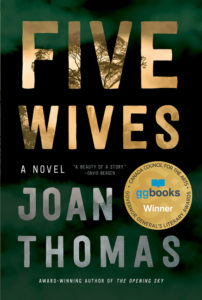November 28, 2019
Five Wives, by Joan Thomas

There’s a possibility I might have let the year pass me by without picking up Joan Thomas’s latest, Five Wives, winner of the 2019 Governor General’s Award for Fiction. And what a disaster that would have been, my reading year without one of the best books of the year included. But disaster was averted because I finally picked up the novel last week, and it was one of those experiences like I mentioned while I was writing about The Dutch House. As in, I was instantly enveloped and not remotley moved to clean my bathroom . (Full disclosure: this novel was actually one of those books I read in the bath until the water got so cold…)
Based on the true story of a group of American evangelical missionaries murdered in the Ecuador jungle in 1956 after making contact with an isolated Indigenous group, Thomas blurs fact and fiction fascinatingly in Five Wives—as she did with her earlier novel, Curiosity, which imaged the life of nineteenth century fossil hunter Mary Anne Anning. Billed as “in the tradition of The Poisonwood Bible,” I actually found the novel more in conversation with Miriam Toews’ Women Talking (with shades of Irma Voth!) in its consideration of the role of women in religious communities, in religion in general, and also with the fraught question of female solidarity. Because as with the women of Women Talking, and women anywhere, actually, and with people in general, the women of Five Wives do not speak with a single voice and view their shared story through very different lenses.
Although when the novel begins, theirs is a collective voice, “the wives,” in the immediate aftermath of the deaths of their husbands. The narrator does not distinguish these women, who themselves are “putting the story together”of what had befallen the men. A story that would become legend in evangelical circles, a story Thomas herself grew up hearing told, as she explains in her interview at 49thShelf. But in her novel, she complicates this mythology and explores the way in which story and narrative is constructed from the raw material of facts.
The novel’s present day story line concerns a young woman called Abby, whose mother and father had each lost their own fathers in the massacre, and had grown up steeped in the story, as her father, David, a pastor, also had. This part of the novel begins at the funeral of Abby’s maternal grandmother, Elizabeth Elliot (a real life figure whose own writings have been instrumental in spreading the story of what happened in the Ecuadorian jungle, and how the Waorani people eventually did convert to Christianity, thereby ensuring that this story of martyrdom ended in triumph and glory). And now Abby has lost her faith, much to the chagrin of her father, and we see the tension between them as she tries to find her own way, which challenges David’s own faith, in many things, including the truth of what he knows about what happened to his father and the story his family continues to tell about it to the world.
More central to the plot are the stories of the wives themselves, however, and their own struggles and challenges, those things they are sure of and that which they doubt. Abby’s grandmother, Betty, for whom missionary work was a vocation, and then Olive, who has followed her husband to Ecuador (and we meet her in the years before her marriage, when she’s attending university and developing independence from her religious family), and Marj, David’s mother, who ran the guesthouse where so many of the missionaries stayed, and her relationship with her sister-in-law, Rachel, the one woman in the group who is nobody’s wife. (“Goodness is more complicated that Marj ever imagined.”
And then Cornell Capa, the photographer from Life Magazine, who took the photographs that showed what happened in the jungle to the world—also a real-life character to whom Thomas grants a fictional inner life. And in the contemporary timeline, a film is being made about the massacre, and so there are lots of opportunities for Thomas to play with and complicate the idea of truth and myth and how stories get told.
The novel is a puzzle, pieces fitting together in surprising ways. The women’s own stories are not told chronologically, and overlap in some aspects and there are gaps in others, and not all the women are as central to the story. There is cultural appeal in this novel about mid-20th century womanhood and wifehood, which Thomas complicates interestingly, in addition to the layer of faith, religion and colonialism which complicates everything even more.






My copy is coming today! So excited!
This wasn’t even on my radar!
And to think she was my grade 10 English teacher in a small southern MB high school. Am loving the book. I also grew up with this story of missionary zeal and sacrifice.
So glad you like it too!! And lucky you to have her for a teacher.
Although I admired the writing virtuosity and craft, I found it dense and found myself often somewhat lost as to chronology and character relationships. The plot outline you furnish is really useful, even at this point. I wish I had had it available prior to reading the book.
Harry
This book could have used a family tree or a list of characters. Even so, I found it a captivating account of a real-life story, with fascinating character additions. The observations and descriptions of the wives (and one sister) was beautifully written..
So glad you enjoyed it!